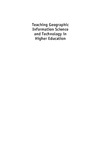Geographic Information Science and Technology (GISc&T) has been at the forefront of education innovation in geography and allied sciences for two decades.
Teaching Geographic Information Science and Technology in Higher Education is an invaluable reference for educators and researchers working in GISc&T, providing coverage of the latest innovations in the field and discussion of what the future holds for GI Science education in the years to come.
This book clearly documents teaching innovations and takes stock of lessons learned from experience in the discipline. The content will be of interest both to educators and researchers working in GISc&T, and to educators in other related fields. More importantly, this book also anticipates some of the opportunities and challenges in GI Science and Technology education that may arise in the next decade. As such it will be of interest to chairs, deans, administrators, faculty in other subfields, and educators in general.
- Innovative book taking a look at recent innovations and teaching developments in the course provision of GI Science and Technology in higher education.
- Edited by leaders in the field of GISc&T who have been at the forefront of education innovation in GI Science and allied science subjects.
- Provides coverage of GISc & Technology in a range of institutional settings from an international perspective at all levels of higher education.
- An invaluable text for all educators within the field of GISc&T and allied subjects with advice from experts in the field on best practice.
- Includes coverage and practical advice on curriculum design, teaching with GIS technology, distance and eLearning with global examples from leading academics in the field.
Content:
Chapter 1 GIS&T in Higher Education: Challenges for Educators, Opportunities for Education (pages 1–15): Kenneth E. Foote, David J. Unwin, Nicholas J. Tate and David Dibiase
Chapter 2 Making the Case for GIS&T in Higher Education (pages 17–36): Diana S. Sinton
Chapter 3 The Internationalization of Esri Higher Education Support, 1992–2009 (pages 37–45): Michael Phoenix
Chapter 4 Reflections on Curriculum Development in the US and Abroad: From Core Curriculum to Body of Knowledge (pages 47–59): Karen K. Kemp
Chapter 5 Using the GIS&T Body of Knowledge for Curriculum Design: Different Design for Different Contexts (pages 61–80): Steven D. Prager
Chapter 6 Scope and Sequence in GIS&T Education: Learning Theory, Learning Cycles and Spiral Curricula (pages 81–95): Kenneth E. Foote
Chapter 7 Building Dynamic, Ontology?Based Alternative Paths for GIS&T Curricula (pages 97–115): Marco Painho and Paula Curvelo
Chapter 8 Addressing Misconceptions, Threshold Concepts, and Troublesome Knowledge in GIScience Education (pages 117–132): Matthew Bampton
Chapter 9 Active Pedagogy Leading to Deeper Learning: Fostering Metacognition and Infusing Active Learning into the GIS&T Classroom (pages 133–143): Richard B. Schultz
Chapter 10 Where to begin? Getting Started Teaching GIS&T (pages 145–157): Eric West
Chapter 11 Issues in Curriculum and Course Design: Discussion and Prospect (pages 159–164): Kenneth E. Foote
Chapter 12 The University of Minnesota Master of Geographic Information Science (MGIS) Program: A Decade of Experience in Professional Education (pages 165–183): Susanna A. McMaster and Robert B. McMaster
Chapter 13 Geospatial Education at US Community Colleges (pages 185–197): Ann Johnson
Chapter 14 The GIS Professional Ethics Project: Practical Ethics for GIS Professionals (pages 199–209): David DiBiase, Francis Harvey, Christopher Goranson and Dawn Wright
Chapter 15 An Exploration of Spatial Thinking in Introductory GIS Courses (pages 211–229): Injeong Jo, Andrew Klein, Robert S. Bednarz and Sarah W. Bednarz
Chapter 16 Teaching Spatial Literacy and Spatial Technologies in the Digital Humanities (pages 231–246): David J. Bodenhamer and Ian N. Gregory
Chapter 17 Discussion and Prospect (pages 247–253): David J. Unwin
Chapter 18 Virtual Geographic Environments (pages 255–288): Gary Priestnall, Claire Jarvis, Andy Burton, Martin J. Smith and Nick J. Mount
Chapter 19 Using Web?Based GIS and Virtual Globes in Undergraduate Education (pages 289–299): Lynn Songer
Chapter 20 Trying to Build a Wind Farm in a National Park: Experiences of a Geocollaboration Experiment in Second Life (pages 301–325): Nick J. Mount and Gary Priestnall
Chapter 21 From Location?Based Services to Location?Based Learning: Challenges and Opportunities for Higher Education (pages 327–343): David M. Mountain
Chapter 22 GIS is Dead, Long Live GIS&T: An Educational Commentary on the Opening of Pandora's Box (pages 345–358): Nicholas J. Tate
Chapter 23 Media and Communications Systems in Cartographic Education (pages 359–382): William Cartwright
Chapter 24 UNIGIS – Networked Learning over a Distance (pages 383–394): Josef Strobl
Chapter 25 The Esri Virtual Campus (pages 395–403): Nick Frunzi
Chapter 26 Delivering GIScience Education via Blended Learning: The GITTA Experience (pages 405–420): Robert Weibel, Patrick Luscher, Monika Niederhuber, Thomas Grossmann and Susanne Bleisch
Chapter 27 GIS&T in the open Educational Resources Movement (pages 421–437): David Dibiase
Chapter 28 Experiences in ‘e’ and ‘Distance?’ Learning: A Personal Account (pages 439–449): David J. Unwin
Chapter 29 Ways Forward for GIS&T Education (pages 451–467): David Dibiase, Kenneth E. Foote, Nicholas J. Tate and David J. Unwin
 |
|
О проекте
|
|
О проекте


